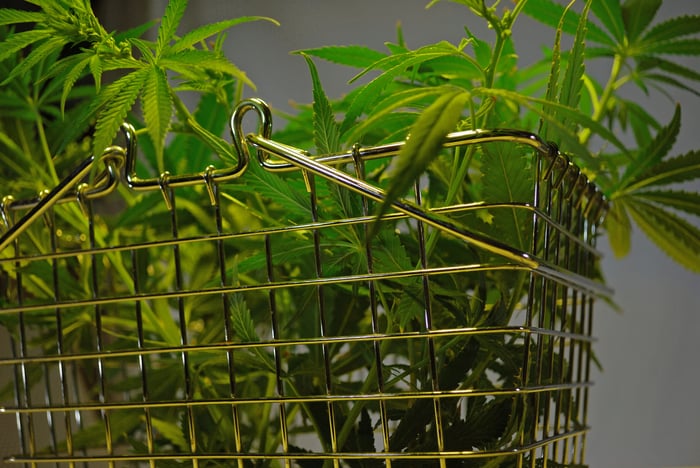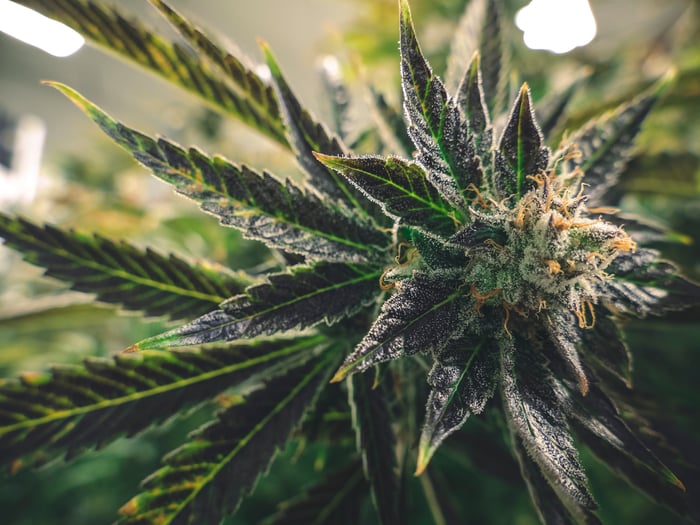There's no denying that there's a lot of buzz surrounding the cannabis space -- and for good reason.
First, Wall Street has tossed around some very prolific long-term sales growth figures for the global marijuana industry. While most estimates have called for $50 billion to $75 billion in full-year sales by the end of the next decade, Stifel analyst Andrew Carter recently came out with a projection of $200 billion in worldwide annual sales a decade from now.
And secondly, we've witnessed incredible returns from marijuana stocks in recent years. Sure, things may have been a bit bumpy of late, but investors who had the foresight and luck to invest in some of the industry's biggest names back in 2016 may have seen returns that top 1,000%.
Investment firms are fully aware of the demand for cannabis stocks with growth prospects looking so bright, which is why a number of marijuana exchange-traded funds (ETFs) have debuted in recent years.
However, this past week investors were introduced to something new on the marijuana ETF front: The Cannabis ETF (THCX), by Innovation Shares.

Image source: Getty Images.
Say hello to the newest marijuana ETF
Without question, The Cannabis ETF gets no bonus points for the originality of its name. But this ETF, which began trading on the NYSE Arca exchange last Tuesday (July 9), is certainly unique from what's already out there in a variety of ways.
For starters, The Cannabis ETF is designed to be a passive investment vehicle, meaning it seeks to mirror the index that it's tracking. In plainer terms, this means that the portfolio managers won't be adjusting The Cannabis ETF to get more defensive when the market turns lower, or more aggressive if another country or state legalizes marijuana in some capacity.
Additionally, this is an ETF that'll be rebalanced far more frequently than its peers. Whereas other marijuana ETFs rebalance every quarter, Innovation Shares' new offering will be rebalanced on a monthly basis. This should result in a more accurate reflection of its tracking index, the Innovation Labs Cannabis Index.
Building on this point, The Cannabis ETF offers the lowest net expense ratio among marijuana funds at 0.70%. This is a few ticks lower than the ETFMG Alternative Harvest ETF at 0.75%, which is the kingpin among marijuana ETFs of total assets under management.
A fourth and final factor that makes this new offering so unique is that it's considered a cannabis pure play, with no alcohol or tobacco stocks included. Instead, the portfolio is focused on cannabis, hemp, and cannabidiol (CBD), the nonpsychoactive cannabinoid best known for its perceived medical benefits.
Matt Markiewicz, the managing director at Innovation Shares, had this to say on the date of The Cannabis ETF's launch:
With several regulatory catalysts on the horizon in the U.S. and abroad, the current cannabis environment presents an exciting opportunity for investors. One area which has witnessed explosive growth since the signing of last year's U.S. Farm Bill is the hemp-derived CBD industry. Several of the companies in the portfolio are actively participating in this CBD boom by cultivating hemp, providing extraction services or by using CBD for applications in the pharmaceutical, health and consumer wellness markets.

Image source: Getty Images.
There are some interesting pot stocks in, and missing from, The Cannabis ETF
At its debut, The Cannabis ETF was invested in 35 stocks, with a good number of these companies located in the United States, a market that would absolutely dwarf Canada if marijuana were legalized.
As you might have already guessed, many of the most popular Canadian growers can be found in this new offering: Canopy Growth, Aurora Cannabis, Cronos Group, HEXO, Aphria, Tilray, OrganiGram Holdings, and many more.
Maybe the bigger surprise is what stock are, and aren't, part of the current holdings.
For example, you won't find KushCo Holdings (KSHB) as one of the ancillary players held by this new cannabis fund. KushCo generates most of its revenue from selling vaporizers, but also provides packaging and branding services to the global pot industry, as well as hydrocarbon gases and solvents that are used in the respective production of cannabis oils and concentrates. KushCo's exclusion is perhaps one of the bigger head-scratchers of this list, especially with vaporizer supplier Greenlane Holdings included.
You also won't find any vertically integrated U.S. dispensary operators. That means no access to MedMen, Curaleaf, Cresco Labs, Harvest Health & Recreation, Trulieve Cannabis, Acreage Holdings, and other U.S.-focused multistate operators.

Image source: Getty Images.
Comparatively, you might be surprised to see a company like Cree (WOLF -14.71%) as a holding. If the name sounds familiar, it's because Cree is a lighting systems giant, with its LED bulbs growing in popularity because of their efficiency and long life-span. It's believed that cannabis growers will consider switching from high-pressure sodium bulbs, which are electricity-intensive and create a lot of heat, to Cree's LED bulbs, which cost less over the long run (despite being pricier up front) and generate less heat.
New Age Beverages (NBEV) is also a surprising entrant in The Cannabis ETF. Although New Age Beverages has a line of nonalcoholic cannabis-infused beverages that aims to take advantage of consumers' growing love for pot derivatives, the vast majority of its business model is dependent on ready-to-drink beverages and dietary supplements that have nothing to do with marijuana. It could be some time before New Age Beverages generates significant sales from its cannabis-infused drink line.
Investors should expect these holdings to change over time, and would be wise to sit back and observe this new ETF for a few months, at minimum, before even thinking about dipping their toes in the water.
